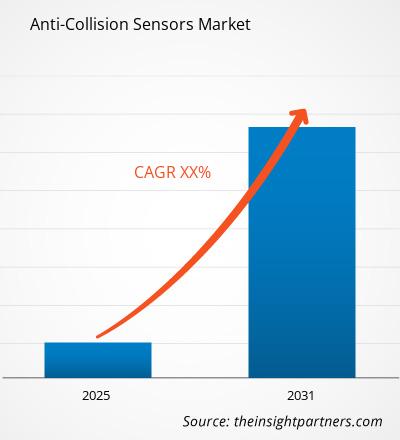MARKET INTRODUCTION
The Anti-Collision Sensors is growing with the number of on-road vehicles coupled with rising road accidents affects the anti-collision technology which is creating profitable opportunities for the Anti-Collision Sensors market in the forecast period.
MARKET DYNAMICS
The mounting demand for advanced automated technology is driving the anti-collision sensors market. The lack of awareness about the features of anti-collision sensors may restrain the growth of the anti-collision sensors market. Furthermore, the recent technological advancements in sensors are focused on building highly sophisticated devices is anticipated to create market opportunities for the Anti-Collision Sensors market during the forecast period.
MARKET SCOPE
The "Global Anti-Collision Sensors Market Analysis to 2031" is a specialized and in-depth study of the Anti-Collision Sensors market with a special focus on the global market trend analysis. The report aims to provide an overview of Anti-Collision Sensors market with detailed market segmentation by sensor technology, vehicle type, application, and geography. The global Anti-Collision Sensors market is expected to witness high growth during the forecast period. The report provides key statistics on the market status of the leading Anti-Collision Sensors market players and offers key trends and opportunities in the Anti-Collision Sensors market.
MARKET SEGMENTATION
The global anti-collision sensors market is segmented on the basis of sensor technology, vehicle type, and application. On the basis of sensor technology, the market is segmented into RADAR, camera, LIDAR, and ultrasonic. Based on vehicle type the market is segmented into passenger vehicle and commercial vehicle. Similarly, on the basis of application the market is segmented into forward collision warning system, blind spot monitor, adaptive cruise sensor, parking sensor, and lane department warning sensor.
REGIONAL FRAMEWORK
The report provides a detailed overview of the industry including both qualitative and quantitative information. It provides overview and forecast of the global Anti-Collision Sensors market based on various segments. It also provides market size and forecast estimates from year 2021 to 2031 with respect to five major regions, namely; North America, Europe, Asia-Pacific (APAC), Middle East and Africa (MEA) and South America. The Anti-Collision Sensors market by each region is later sub-segmented by respective countries and segments. The report covers analysis and forecast of 18 countries globally along with current trend and opportunities prevailing in the region.
The report analyzes factors affecting Anti-Collision Sensors market from both demand and supply side and further evaluates market dynamics effecting the market during the forecast period i.e., drivers, restraints, opportunities, and future trend. The report also provides exhaustive PEST analysis for all five regions namely; North America, Europe, APAC, MEA and South America after evaluating political, economic, social and technological factors effecting the Anti-Collision Sensors market in these regions.
MARKET PLAYERS
The reports cover key developments in the Anti-Collision Sensors market as organic and inorganic growth strategies. Various companies are focusing on organic growth strategies such as product launches, product approvals and others such as patents and events. Inorganic growth strategies activities witnessed in the market were acquisitions, and partnership & collaborations. These activities have paved way for expansion of business and customer base of market players. The market players from Anti-Collision Sensors market are anticipated to lucrative growth opportunities in the future with the rising demand for Anti-Collision Sensors market. Below mentioned is the list of few companies engaged in the Anti-Collision Sensors market.
The report also includes the profiles of key Anti-Collision Sensors market companies along with their SWOT analysis and market strategies. In addition, the report focuses on leading industry players with information such as company profiles, components and services offered, financial information of last 3 years, key development in past five years.
- Autoliv AB
- Continental AG
- Denso Corporation
- Murata Manufacturing Co. Ltd.
- NXP Semiconductors
- Robert Bosch GmbH
- Texas Instruments
- TRW Automotive
- Wadeco
- ZF Friedrichshafen
The Insight Partner's dedicated research and analysis team consist of experienced professionals with advanced statistical expertise and offer various customization options in the existing study.
Anti-Collision Sensors Report Scope
| Report Attribute | Details |
|---|---|
| Market size in 2024 | US$ XX million |
| Market Size by 2031 | US$ XX Million |
| Global CAGR (2025 - 2031) | XX% |
| Historical Data | 2021-2023 |
| Forecast period | 2025-2031 |
| Segments Covered |
By Sensor Technology
|
| Regions and Countries Covered | North America
|
| Market leaders and key company profiles |
- Historical Analysis (2 Years), Base Year, Forecast (7 Years) with CAGR
- PEST and SWOT Analysis
- Market Size Value / Volume - Global, Regional, Country
- Industry and Competitive Landscape
- Excel Dataset
- USB Device Market
- Clinical Trial Supplies Market
- Military Rubber Tracks Market
- Integrated Platform Management System Market
- Hydrocephalus Shunts Market
- Rare Neurological Disease Treatment Market
- Rugged Phones Market
- Micro-Surgical Robot Market
- Dealer Management System Market
- Smart Grid Sensors Market

Report Coverage
Revenue forecast, Company Analysis, Industry landscape, Growth factors, and Trends

Segment Covered
This text is related
to segments covered.

Regional Scope
North America, Europe, Asia Pacific, Middle East & Africa, South & Central America

Country Scope
This text is related
to country scope.
Trends and growth analysis reports related to Electronics and Semiconductor : READ MORE..
The List of Companies
1. Autoliv AB
2. Continental AG
3. Denso Corporation
4. Murata Manufacturing Co. Ltd.
5. NXP Semiconductors
6. Robert Bosch GmbH
7. Texas Instruments
8. TRW Automotive
9. Wadeco
10. ZF Friedrichshafen
1. Autoliv AB
2. Continental AG
3. Denso Corporation
4. Murata Manufacturing Co. Ltd.
5. NXP Semiconductors
6. Robert Bosch GmbH
7. Texas Instruments
8. TRW Automotive
9. Wadeco
10. ZF Friedrichshafen



 Get Free Sample For
Get Free Sample For